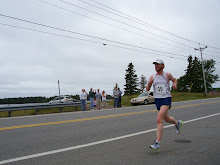Some 1200 meter repeats
Today's 10 miler was done at the local airport. The airport is 3/4 mile long or 1200 meters on the conservative side. The plan was to run 7 repeats and 7 recovery jogs back up the airstrip. No stress, just a quick turnover and "in control". The weather was beautiful with little wind and temp's in the 70's. The splits (w/pace):
4:38 (6:13)
4:39 (6:14)
4:36 (6:10)
4:42 (6:18)
4:45 (6:22)
4:54 (6:34)
4:52 (6:32)
My average pace for recovery was 10:37. Only one plane tried to land while I was running. It's a popular airstrip for small planes hopping into the United States from Canada since Eastport has its own Customs and Immigration outpost due to our shipping port and summer border crossing. Planes land, clear Customs, then continue on their U.S. journey. Anyway, it's always a thrill to be running along and have aircraft land beside you. A slower version of Top Gun. Perhaps "Top Run"?
"Negative, Ghostrunner. The pattern is full..."
Today's 10.8 miles(1:32:36 HR 151 / 8:34 avg pace) ended my week at 104.6 miles. I ran .8 miles less than less week but it took me 7 minutes longer. Last week I ran an average 8:10 pace and this week an 8:18 pace. I took an 15 extra minutes on my long run this week. But my Parrot Predictor dropped by 14 minutes. Itemizing the repeat splits contributes to this since the computer can "grab" the lower times and not have them averaged into a slower total time. I don't rely on these "predictors" but it does add some fun to the numbers. For example, this week my predictor says 3:06 marathon. If I fiddle with the splits above and Yasso-ize them I come up with a 3:10 performance. Some more fiddling with time equivalents predicts 3:04 to 3:11. My recent 5 mile race predicts 3:02.
The range between 3:02 and 3:11 is very large but notice anything? There's no awesome prediction at 2:50 or any that is a lot slower. And if you grant greater predictive power to these numbers when they are produced from high mileage training of many weeks they can be fun to track. I admit that they can really throw off a low mileage runner. Imagine running 27 miles per week rather fast and having the parrot predict a low marathon finish time. Disaster waiting to happen.
My intention with this training cycle (of 5 short weeks) leading up to the Wineglass marathon has always been to "salvage" a 3:10 from my summer of injury. I'm under no illusions that I can really run my fastest ever etc. However, I'm feeling that, given the right racing strategy, I can cover the distance in under 3:10. I feel that way now. Hopefully, this will even solidfy further as I continue the high mileage.
4:38 (6:13)
4:39 (6:14)
4:36 (6:10)
4:42 (6:18)
4:45 (6:22)
4:54 (6:34)
4:52 (6:32)
My average pace for recovery was 10:37. Only one plane tried to land while I was running. It's a popular airstrip for small planes hopping into the United States from Canada since Eastport has its own Customs and Immigration outpost due to our shipping port and summer border crossing. Planes land, clear Customs, then continue on their U.S. journey. Anyway, it's always a thrill to be running along and have aircraft land beside you. A slower version of Top Gun. Perhaps "Top Run"?
"Negative, Ghostrunner. The pattern is full..."
Today's 10.8 miles(1:32:36 HR 151 / 8:34 avg pace) ended my week at 104.6 miles. I ran .8 miles less than less week but it took me 7 minutes longer. Last week I ran an average 8:10 pace and this week an 8:18 pace. I took an 15 extra minutes on my long run this week. But my Parrot Predictor dropped by 14 minutes. Itemizing the repeat splits contributes to this since the computer can "grab" the lower times and not have them averaged into a slower total time. I don't rely on these "predictors" but it does add some fun to the numbers. For example, this week my predictor says 3:06 marathon. If I fiddle with the splits above and Yasso-ize them I come up with a 3:10 performance. Some more fiddling with time equivalents predicts 3:04 to 3:11. My recent 5 mile race predicts 3:02.
The range between 3:02 and 3:11 is very large but notice anything? There's no awesome prediction at 2:50 or any that is a lot slower. And if you grant greater predictive power to these numbers when they are produced from high mileage training of many weeks they can be fun to track. I admit that they can really throw off a low mileage runner. Imagine running 27 miles per week rather fast and having the parrot predict a low marathon finish time. Disaster waiting to happen.
My intention with this training cycle (of 5 short weeks) leading up to the Wineglass marathon has always been to "salvage" a 3:10 from my summer of injury. I'm under no illusions that I can really run my fastest ever etc. However, I'm feeling that, given the right racing strategy, I can cover the distance in under 3:10. I feel that way now. Hopefully, this will even solidfy further as I continue the high mileage.


0 Comments:
Post a Comment
<< Home